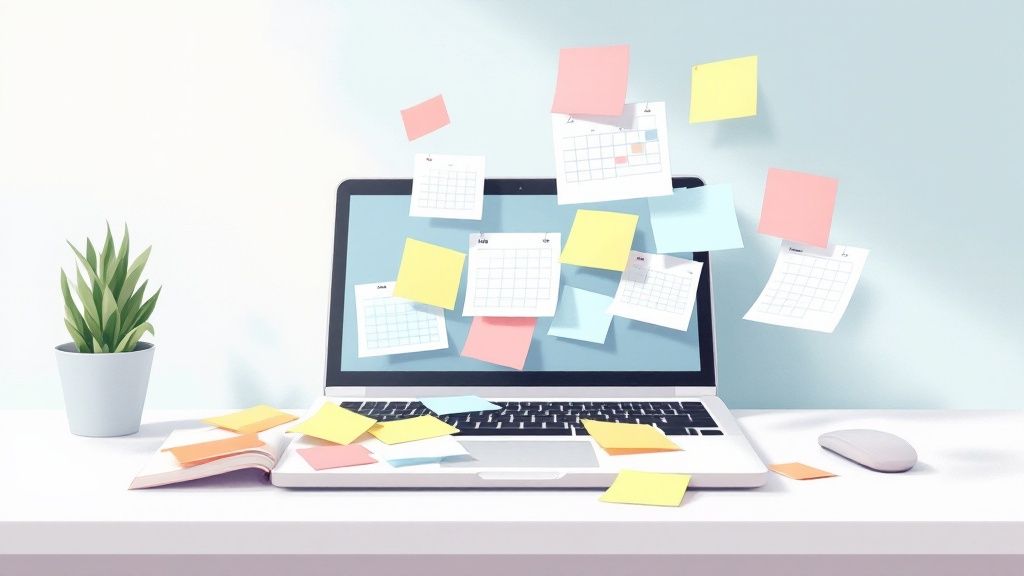Attention-Deficit/Hyperactivity Disorder (ADHD) is often thought of as a childhood condition, but it affects many adults, too. For adults, the experience can be complex, often leading to challenges with focus, emotions, and organisation that may be mistaken for personal shortcomings. This misunderstanding can cause significant workplace stress and anxiety, impacting overall well-being.
This guide offers a warm and supportive look into the common ADHD symptoms in adults, moving beyond stereotypes. Our goal is to provide clear insights, helping you recognise patterns that might affect your life or someone you care about. We will explore both the challenges and the unique strengths, like resilience and creativity, that can come with an ADHD mind.
This article provides information, not a diagnosis. If these descriptions feel familiar, it could be a helpful first step toward seeking professional counselling or an assessment for personalised support.
1. Inattentive Type – Difficulty Sustaining Focus
A core ADHD symptom in adults is a constant challenge in holding focus. This isn't just boredom; it's a genuine difficulty in paying attention to tasks or conversations that aren't highly engaging. An adult might feel like their brain has too many tabs open at once, pulling their attention in different directions.
In adults, this can look different than in children. Instead of being physically restless, an adult might seem quiet while their mind wanders during an important meeting or a conversation with a loved one. This internal experience of a constantly shifting mind can make it exhausting to complete projects that require long-term mental effort.
How It Manifests in Daily Life
Difficulty with focus can impact well-being in both personal and professional life, sometimes leading to workplace stress and feelings of inadequacy.
- At Work: A talented professional might miss important details in reports or make simple mistakes, not due to lack of skill but because their focus drifts.
- At Home: A parent may forget appointments or struggle to finish household chores, often starting several tasks but completing none.
- In Relationships: Partners may feel unheard when the person with ADHD loses track of conversations, which comes from an attention challenge, not a lack of care.
Actionable Strategies to Improve Focus
While a professional assessment is important, you can try strategies to manage this symptom. Structuring your tasks and environment can make a real difference.
- Use Time-Blocking Techniques: The Pomodoro Technique, using focused 25-minute work periods with short breaks, can make large tasks feel more manageable.
- Externalise Your Plans: Use detailed checklists or apps to keep track of steps. Resources like the best focus apps for people with ADHD can offer practical support.
- Minimise Distractions: Create a calmer environment by using noise-cancelling headphones, turning off phone notifications, or finding a quiet space to work.
2. Hyperactivity-Impulsivity – Restlessness and Hasty Decision Making
While childhood hyperactivity often involves visible energy like running and climbing, it shows up more subtly in adults. It can feel like an inner restlessness or a mind that is always on the go. This is often paired with impulsivity—acting on sudden urges without fully thinking about the consequences.

This inner drive can make quiet activities feel difficult and can lead to fidgeting, tapping your feet, or pacing. Impulsivity is not a character flaw; it’s a challenge with self-regulation that can affect work, finances, and relationships, sometimes leading to workplace stress and anxiety.
How It Manifests in Daily Life
The mix of restlessness and impulsivity can create challenges that affect an adult's sense of control and well-being.
- At Work: A colleague might interrupt others in meetings, not to be rude, but because an idea feels too urgent to hold back.
- At Home: An individual might make a large, impulsive purchase online that affects the family budget, or suddenly start a big home project without a plan.
- In Relationships: This can show up as saying things without thinking, which might be hurtful, or making big life decisions, like quitting a job, without discussion.
Actionable Strategies to Manage Impulses
Learning to manage hyperactivity and impulsivity involves building awareness and creating pauses. While professional counselling can offer a tailored approach, these strategies can help.
- Implement a 'Waiting Period': For big decisions, try to create a 24 to 48-hour waiting period. This provides a buffer between the impulse and the action.
- Channel Restless Energy: Using a discreet fidget tool during long meetings can help manage excess energy. Short, frequent breaks to walk or stretch also help.
- Practise Mindfulness: Mindfulness exercises can strengthen your brain's ability to notice thoughts and feelings without immediately acting on them.
3. Executive Functioning Deficits – Problems with Mental Management
Beyond attention, many ADHD symptoms in adults are linked to challenges with executive functions. These are the brain's "management" skills, responsible for organising, planning, and getting tasks done. When this system is less effective, it creates challenges in managing daily life.

This isn't about intelligence or effort; it's a neurobiological difference in high-level thinking skills. An adult with these challenges might feel constantly overwhelmed, as if they are always trying to keep up. This can lead to significant workplace stress and a persistent feeling of being behind.
How It Manifests in Daily Life
Difficulties with executive function can affect an adult's ability to reach long-term goals and manage daily tasks, which may contribute to anxiety.
- At Work: A project manager may find it hard to estimate how long tasks will take, leading to missed deadlines and team frustration.
- At Home: An individual might find it very difficult to organise a multi-step task like preparing for a festival or managing household bills.
- In Personal Growth: A student might have wonderful ideas but struggle to structure them, create an outline, or manage their time to complete their work.
Actionable Strategies to Improve Management
Building external support systems can help compensate for internal executive function challenges, creating a "scaffolding" for the brain.
- Break Down Large Projects: Turn overwhelming goals into small, clear, and actionable steps. For example, "organise office" becomes "clear desk," then "sort papers."
- Use Time-Blocking: Schedule specific blocks of time in a calendar for every task, including breaks, and set multiple reminders to help with time perception.
- Externalise Your Memory: Don't rely on your memory alone. Use external aids like phone notes, voice memos, or a physical notebook to keep track of ideas and to-do lists.
4. Emotional Dysregulation – Intense and Rapidly Changing Emotions
Though not an official diagnostic criterion, emotional dysregulation is one of the most impactful ADHD symptoms in adults. It means having difficulty managing emotional responses in a way that feels balanced for the situation. This can look like intense reactions to small frustrations or quick mood shifts.

Living with this can feel like being on an emotional rollercoaster, causing both personal and workplace stress. An adult with ADHD might experience sudden anger over a minor issue or feel overwhelming sadness from gentle criticism. This is a challenge with emotional control, linked to the brain's executive functions.
How It Manifests in Daily Life
Unmanaged emotional responses can strain relationships and are often misunderstood by others, which can lead to anxiety and feelings of isolation.
- At Work: A team member might get very frustrated over a small technical glitch, affecting team morale. A manager’s mood could shift quickly, creating an unpredictable environment.
- At Home: A small disagreement with a partner could escalate into a big argument. An individual might feel overwhelmed for hours after a stressful event.
- In Relationships: Friends and family might feel like they need to be very careful, unsure what might trigger an intense emotional reaction.
Actionable Strategies for Emotional Regulation
Building emotional awareness is key to managing this symptom. While professional counselling provides tailored support, these strategies can help build emotional resilience.
- Practise the STOP Technique: When you feel a strong emotion rising, Stop. Take a breath. Observe your feelings without judgement. Proceed mindfully.
- Develop an Emotional Recovery Routine: Create a personal toolkit for when you feel overwhelmed. This could be a short walk, listening to calming music, or deep breathing.
- Communicate Your Needs Clearly: Let trusted friends and family know you sometimes experience intense emotions and explain what helps you in those moments.
5. Rejection Sensitive Dysphoria (RSD) – Extreme Fear of Criticism
One of the most intense emotional ADHD symptoms in adults is Rejection Sensitive Dysphoria (RSD). This is an extreme emotional sensitivity to the perception of being rejected, criticised, or failing. It’s an overwhelming emotional response to situations that others might not find as painful.
This intense reaction can seem out of proportion, but for the person experiencing it, the emotional pain is very real. The constant fear of this pain can lead to behaviours like trying very hard to please others or avoiding situations where criticism is possible.
How It Manifests in Daily Life
The fear of rejection can create chronic anxiety and impact self-worth, making it difficult to pursue goals and maintain healthy relationships.
- At Work: An employee might take constructive feedback as a personal attack, leading to feelings of worthlessness or a defensive reaction.
- At Home: A person might avoid discussing difficult topics with their partner to prevent potential disapproval, which can lead to unresolved issues.
- In Social Situations: Someone might avoid a new hobby or opportunity, not because they can't do it, but to avoid the risk of perceived failure.
Actionable Strategies to Manage RSD
Managing RSD involves building emotional resilience and finding new ways to view feedback. While professional therapy is very helpful, these strategies can offer support.
- Practise Cognitive Reframing: When you feel rejected, gently question your first interpretation. Ask yourself: "Is there another way to see this?"
- Develop a Support Network: Talk about your experiences with a trusted friend, partner, or therapist. A supportive person can offer a different perspective and reduce feelings of isolation.
- Use Mindfulness Techniques: Practise noticing your emotions without judgement. Acknowledge the feeling as a symptom, rather than a fact. This creates a little space between the trigger and your reaction.
6. Hyperfocus – Intense Concentration on Preferred Activities
While ADHD is known for a lack of focus, a surprising symptom in adults is hyperfocus. This is a long, intense state of concentration on an activity that is interesting or rewarding. The brain locks onto a stimulating task, often tuning out everything else.
During hyperfocus, an adult can become so absorbed that they lose track of time and forget basic needs like eating or sleeping. While this can lead to amazing productivity and creativity, it can also disrupt balance in daily life and contribute to workplace stress or personal neglect.
How It Manifests in Daily Life
Hyperfocus can be both a great strength and a challenge, leading to high achievement but also missed responsibilities.
- At Work: A developer might code for 12 hours straight to fix a complex problem but miss important meetings and forget to take a break.
- At Home: An artist could get so lost in a project that they miss family dinner or ignore phone calls, which can cause strain in relationships.
- In Personal Pursuits: A person might spend an entire weekend absorbed in a fascinating new hobby, making great progress but neglecting household chores.
Actionable Strategies to Manage Hyperfocus
Learning to channel hyperfocus is key to making it an asset. The goal is not to stop it but to manage its timing and intensity.
- Set External Cues: Use alarms or timers to create "break points." These reminders can pull you out of a hyperfocused state to check on other priorities.
- Schedule Hyperfocus Time: Set aside time for engaging activities when it won’t disrupt other important responsibilities.
- Communicate with Loved Ones: Explain your hyperfocus patterns to your family and partner. This helps them understand and reduces misunderstandings when you become temporarily absorbed in something.
7. Time Blindness – Distorted Perception of Time Passage
One of the more disorienting ADHD symptoms in adults is "time blindness," a difficulty in accurately sensing the passage of time. This isn't just poor time management; it's a neurological challenge where the brain struggles to feel how much time has passed or how long a task will take. It can lead to chronic lateness and missed deadlines.
This symptom is a core part of executive function challenges in ADHD and can cause significant workplace stress and anxiety. It explains why a "quick five-minute" task can turn into an hour, or a deadline that seems far away suddenly arrives tomorrow.
How It Manifests in Daily Life
Time blindness can affect all areas of life and is often misunderstood as carelessness, which can harm relationships and self-esteem.
- At Work: A person might consistently arrive late for meetings, not from a lack of respect, but from underestimating travel time.
- At Home: A parent might find mornings chaotic and stressful, frequently running late for school drop-offs.
- In Relationships: Someone might get lost in a hobby and forget a planned dinner with their partner, which can be perceived as neglect.
Actionable Strategies to Manage Time Blindness
While a professional assessment can bring clarity, you can use strategies to make time more concrete. The goal is to create external structures to help with the brain's internal timing.
- Make Time Visible: Use analog clocks where you can see the hands move, or countdown timers. This makes the passage of time more tangible.
- Build in Buffer Time: If you think a task will take 30 minutes, schedule 45. Adding extra time to schedules can reduce the stress of being late.
- Use External Reminders: Set multiple alarms for important events—for example, an hour before, 30 minutes before, and when it's time to leave.
- Track Your Time: To learn more about managing this, you can explore effective time management strategies specifically for adults with ADHD.
7-Point ADHD Symptom Comparison in Adults
| Symptom / Aspect | Implementation Complexity 🔄 | Resource Requirements 🔄 | Expected Outcomes 📊 | Ideal Use Cases 💡 | Key Advantages ⭐ |
|---|---|---|---|---|---|
| Inattentive Type – Difficulty Sustaining Focus | Moderate – requires consistent strategies | Moderate – checklists, apps, environment control | Moderate improvement in focus and task completion | Office work, project management, household tasks | Enhanced creativity, detail orientation |
| Hyperactivity-Impulsivity – Restlessness and Hasty Decision Making | Moderate – mindfulness and structure needed | Moderate – mindfulness tools, fidget devices | Improved impulse control and decision-making accuracy | Fast-paced environments, sales, dynamic team settings | High energy, quick decisions |
| Executive Functioning Deficits – Problems with Mental Management | High – involves complex organizational methods | High – calendar apps, memory aids, methodologies | Significant improvement in planning and deadlines | Project management, academia, entrepreneurship | Strong crisis management, creative solutions |
| Emotional Dysregulation – Intense and Rapidly Changing Emotions | Moderate – emotional regulation techniques | Moderate – apps, therapy, mindfulness practices | Better emotional stability and relationship quality | Professions requiring emotional resilience, caregiving | Deep empathy, passionate engagement |
| Rejection Sensitive Dysphoria (RSD) – Extreme Fear of Criticism | High – cognitive and behavioral adjustments | High – therapy, medication, support networks | Reduced emotional pain and improved social interactions | Creative professions, social work, client-facing roles | High empathy, motivation to excel |
| Hyperfocus – Intense Concentration on Preferred Activities | Low to Moderate – scheduling and alarms | Low – timers, reminders | Exceptional productivity in focused tasks | Creative arts, research, programming, emergency medicine | Exceptional work quality under focus |
| Time Blindness – Distorted Perception of Time Passage | Moderate – requires external aids and awareness | Moderate – apps, alarms, visual tools | Improved punctuality and deadline management | Consulting, writing, parenting | Ability for flow states, reduced time anxiety |
Embracing Your Unique Mind: Your Path Forward
Understanding your mind is the first step on a positive path forward. We've explored the diverse and often misunderstood adhd symptoms in adults, from the quiet challenge of inattention to the intense feelings of emotional dysregulation. Recognising these patterns is not about finding flaws but about seeing the unique way your brain works.
Perhaps you saw yourself in "time blindness" or connected with the idea of hyperfocus. Understanding these traits is the foundation for self-compassion. It allows you to move away from self-criticism and toward building a life that works for you.
From Recognition to Actionable Strategy
Living with unmanaged ADHD symptoms can contribute to workplace stress, anxiety, and feelings of depression. It can be exhausting to constantly manage organisation, priorities, and emotions. However, identifying these patterns empowers you to seek the right support and build a life that honours your brain's natural style.
The goal is not to "fix" a core part of who you are but to build skills and strategies that support your well-being and resilience. This journey can include:
- Seeking Professional Insight: A formal assessment with a qualified professional can provide clarity and open the door to support like therapy or counselling. Remember, an assessment is informational, not just a label.
- Developing Personalised Systems: Work with your brain, not against it. If you struggle with time, visual timers can become your friend. If emotions feel big, counselling can help you develop mindfulness techniques.
- Leveraging Your Strengths: Remember that an ADHD brain has incredible strengths. The same mind that wanders can also achieve amazing hyperfocus, leading to creativity and innovation. Building on these strengths is key to confidence and happiness.
Supportive Takeaways for Your Journey
Understanding common adhd symptoms in adults is an act of self-advocacy. It’s the key to transforming daily struggles into manageable challenges and using your unique strengths to live a more balanced and joyful life. This journey requires patience, self-compassion, and a willingness to seek support. You are not alone, and help is available to guide you toward a life where you can truly thrive.
Ready to take the next step in understanding your mind? On DeTalks, you can explore scientifically validated assessments for deeper insights or connect with qualified mental health professionals across India who specialise in adult ADHD. Start your journey towards clarity and well-being today at DeTalks.

Leave a Reply